PCEHR: Evaluating Impact on Person-Centered Care & Barriers
VerifiedAdded on 2023/06/04
|7
|1464
|490
Report
AI Summary
This report provides an analysis of Personal Controlled Electronic Health Records (PCEHR), focusing on their purpose, benefits, and challenges. It explains how PCEHR upholds the nursing philosophy of person-centered care by empowering patients with control over their medical records and enhancing communication with healthcare providers. The report identifies barriers to PCEHR implementation, such as lack of public awareness and health illiteracy. It also incorporates the Gibbs Reflective Cycle to assess the impact of the system and propose improvements in security. The analysis concludes that PCEHRs can streamline healthcare procedures and improve accessibility to medical records, fostering greater openness and control in the medical sector. Desklib offers a variety of resources, including past papers and solved assignments, to support students in their studies.
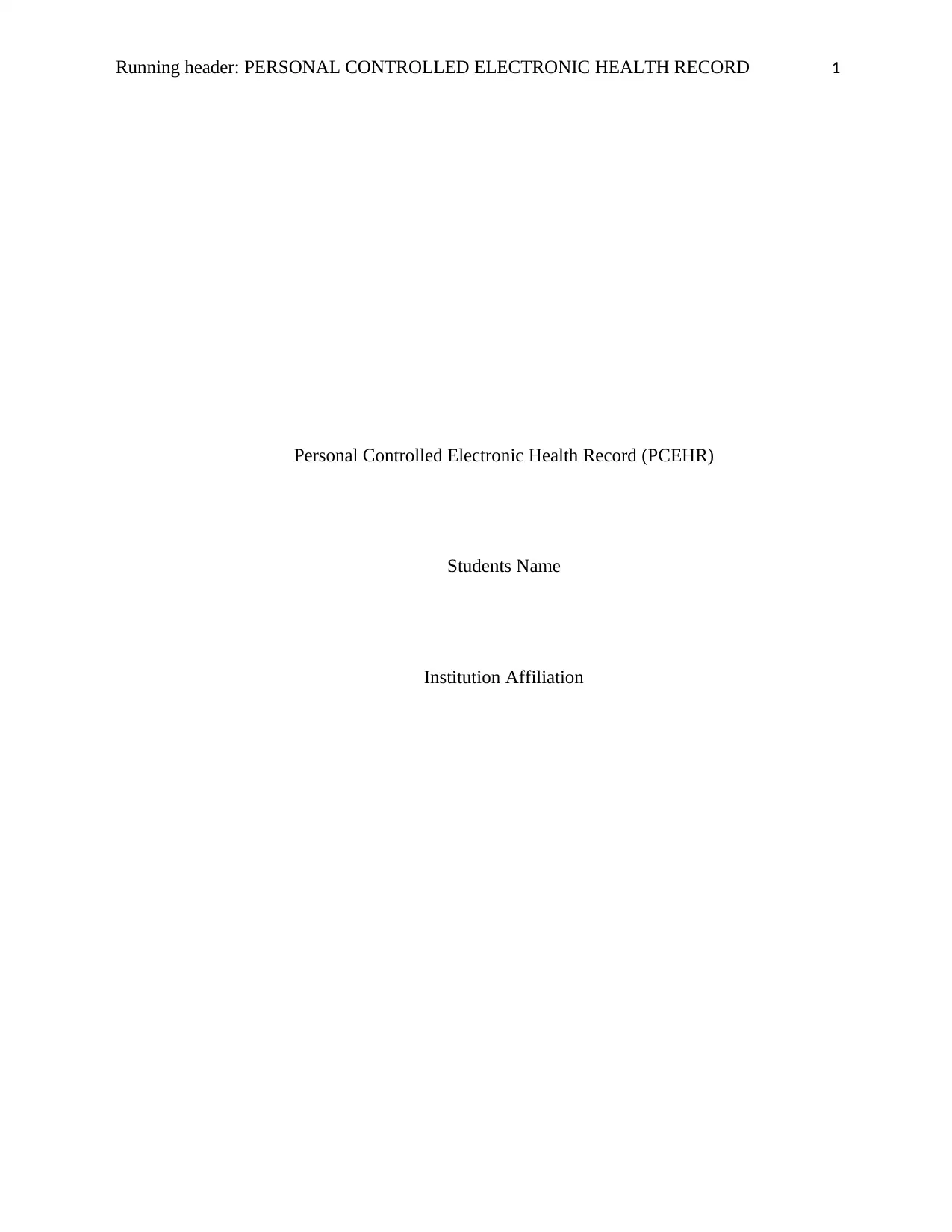
Running header: PERSONAL CONTROLLED ELECTRONIC HEALTH RECORD 1
Personal Controlled Electronic Health Record (PCEHR)
Students Name
Institution Affiliation
Personal Controlled Electronic Health Record (PCEHR)
Students Name
Institution Affiliation
Paraphrase This Document
Need a fresh take? Get an instant paraphrase of this document with our AI Paraphraser
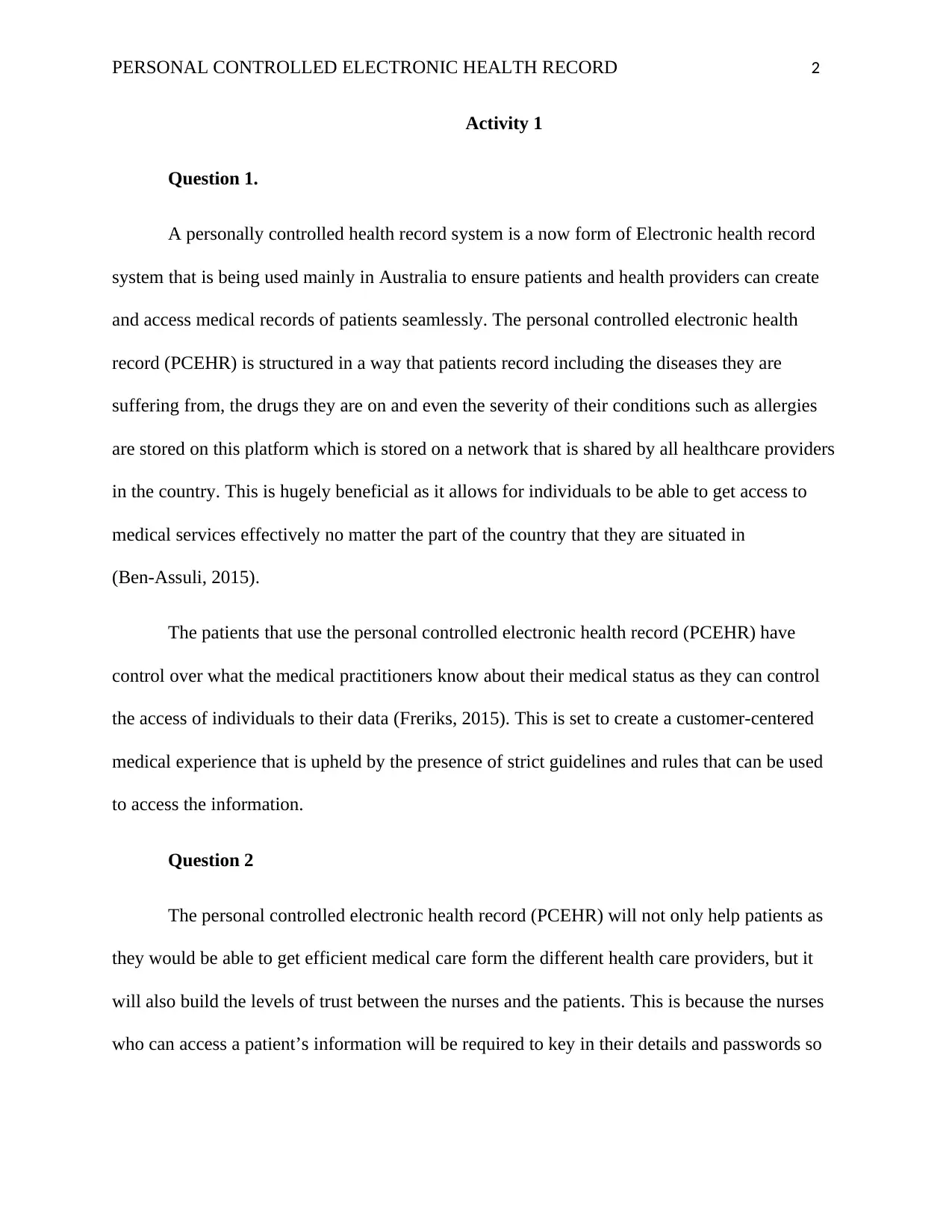
PERSONAL CONTROLLED ELECTRONIC HEALTH RECORD 2
Activity 1
Question 1.
A personally controlled health record system is a now form of Electronic health record
system that is being used mainly in Australia to ensure patients and health providers can create
and access medical records of patients seamlessly. The personal controlled electronic health
record (PCEHR) is structured in a way that patients record including the diseases they are
suffering from, the drugs they are on and even the severity of their conditions such as allergies
are stored on this platform which is stored on a network that is shared by all healthcare providers
in the country. This is hugely beneficial as it allows for individuals to be able to get access to
medical services effectively no matter the part of the country that they are situated in
(Ben-Assuli, 2015).
The patients that use the personal controlled electronic health record (PCEHR) have
control over what the medical practitioners know about their medical status as they can control
the access of individuals to their data (Freriks, 2015). This is set to create a customer-centered
medical experience that is upheld by the presence of strict guidelines and rules that can be used
to access the information.
Question 2
The personal controlled electronic health record (PCEHR) will not only help patients as
they would be able to get efficient medical care form the different health care providers, but it
will also build the levels of trust between the nurses and the patients. This is because the nurses
who can access a patient’s information will be required to key in their details and passwords so
Activity 1
Question 1.
A personally controlled health record system is a now form of Electronic health record
system that is being used mainly in Australia to ensure patients and health providers can create
and access medical records of patients seamlessly. The personal controlled electronic health
record (PCEHR) is structured in a way that patients record including the diseases they are
suffering from, the drugs they are on and even the severity of their conditions such as allergies
are stored on this platform which is stored on a network that is shared by all healthcare providers
in the country. This is hugely beneficial as it allows for individuals to be able to get access to
medical services effectively no matter the part of the country that they are situated in
(Ben-Assuli, 2015).
The patients that use the personal controlled electronic health record (PCEHR) have
control over what the medical practitioners know about their medical status as they can control
the access of individuals to their data (Freriks, 2015). This is set to create a customer-centered
medical experience that is upheld by the presence of strict guidelines and rules that can be used
to access the information.
Question 2
The personal controlled electronic health record (PCEHR) will not only help patients as
they would be able to get efficient medical care form the different health care providers, but it
will also build the levels of trust between the nurses and the patients. This is because the nurses
who can access a patient’s information will be required to key in their details and passwords so
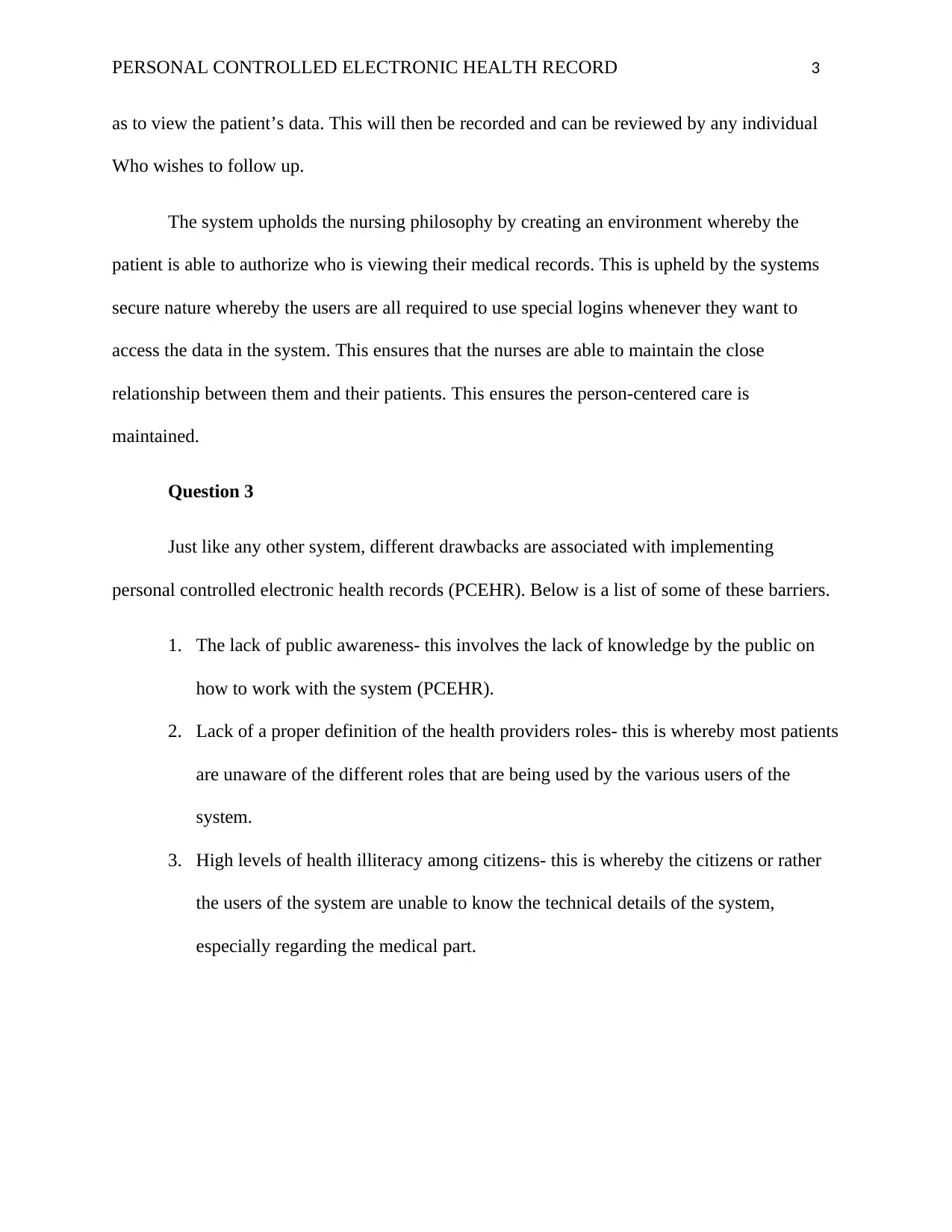
PERSONAL CONTROLLED ELECTRONIC HEALTH RECORD 3
as to view the patient’s data. This will then be recorded and can be reviewed by any individual
Who wishes to follow up.
The system upholds the nursing philosophy by creating an environment whereby the
patient is able to authorize who is viewing their medical records. This is upheld by the systems
secure nature whereby the users are all required to use special logins whenever they want to
access the data in the system. This ensures that the nurses are able to maintain the close
relationship between them and their patients. This ensures the person-centered care is
maintained.
Question 3
Just like any other system, different drawbacks are associated with implementing
personal controlled electronic health records (PCEHR). Below is a list of some of these barriers.
1. The lack of public awareness- this involves the lack of knowledge by the public on
how to work with the system (PCEHR).
2. Lack of a proper definition of the health providers roles- this is whereby most patients
are unaware of the different roles that are being used by the various users of the
system.
3. High levels of health illiteracy among citizens- this is whereby the citizens or rather
the users of the system are unable to know the technical details of the system,
especially regarding the medical part.
as to view the patient’s data. This will then be recorded and can be reviewed by any individual
Who wishes to follow up.
The system upholds the nursing philosophy by creating an environment whereby the
patient is able to authorize who is viewing their medical records. This is upheld by the systems
secure nature whereby the users are all required to use special logins whenever they want to
access the data in the system. This ensures that the nurses are able to maintain the close
relationship between them and their patients. This ensures the person-centered care is
maintained.
Question 3
Just like any other system, different drawbacks are associated with implementing
personal controlled electronic health records (PCEHR). Below is a list of some of these barriers.
1. The lack of public awareness- this involves the lack of knowledge by the public on
how to work with the system (PCEHR).
2. Lack of a proper definition of the health providers roles- this is whereby most patients
are unaware of the different roles that are being used by the various users of the
system.
3. High levels of health illiteracy among citizens- this is whereby the citizens or rather
the users of the system are unable to know the technical details of the system,
especially regarding the medical part.
⊘ This is a preview!⊘
Do you want full access?
Subscribe today to unlock all pages.

Trusted by 1+ million students worldwide
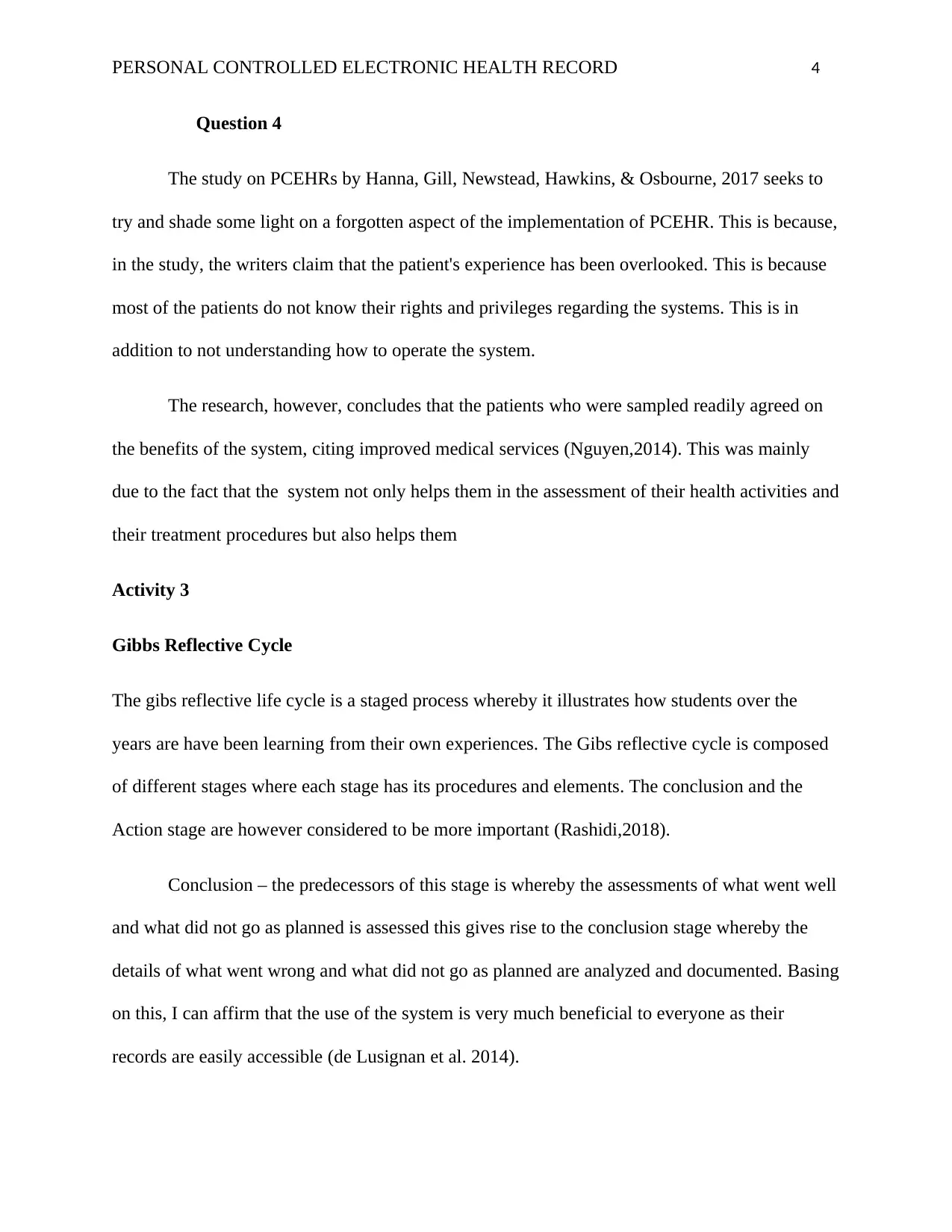
PERSONAL CONTROLLED ELECTRONIC HEALTH RECORD 4
Question 4
The study on PCEHRs by Hanna, Gill, Newstead, Hawkins, & Osbourne, 2017 seeks to
try and shade some light on a forgotten aspect of the implementation of PCEHR. This is because,
in the study, the writers claim that the patient's experience has been overlooked. This is because
most of the patients do not know their rights and privileges regarding the systems. This is in
addition to not understanding how to operate the system.
The research, however, concludes that the patients who were sampled readily agreed on
the benefits of the system, citing improved medical services (Nguyen,2014). This was mainly
due to the fact that the system not only helps them in the assessment of their health activities and
their treatment procedures but also helps them
Activity 3
Gibbs Reflective Cycle
The gibs reflective life cycle is a staged process whereby it illustrates how students over the
years are have been learning from their own experiences. The Gibs reflective cycle is composed
of different stages where each stage has its procedures and elements. The conclusion and the
Action stage are however considered to be more important (Rashidi,2018).
Conclusion – the predecessors of this stage is whereby the assessments of what went well
and what did not go as planned is assessed this gives rise to the conclusion stage whereby the
details of what went wrong and what did not go as planned are analyzed and documented. Basing
on this, I can affirm that the use of the system is very much beneficial to everyone as their
records are easily accessible (de Lusignan et al. 2014).
Question 4
The study on PCEHRs by Hanna, Gill, Newstead, Hawkins, & Osbourne, 2017 seeks to
try and shade some light on a forgotten aspect of the implementation of PCEHR. This is because,
in the study, the writers claim that the patient's experience has been overlooked. This is because
most of the patients do not know their rights and privileges regarding the systems. This is in
addition to not understanding how to operate the system.
The research, however, concludes that the patients who were sampled readily agreed on
the benefits of the system, citing improved medical services (Nguyen,2014). This was mainly
due to the fact that the system not only helps them in the assessment of their health activities and
their treatment procedures but also helps them
Activity 3
Gibbs Reflective Cycle
The gibs reflective life cycle is a staged process whereby it illustrates how students over the
years are have been learning from their own experiences. The Gibs reflective cycle is composed
of different stages where each stage has its procedures and elements. The conclusion and the
Action stage are however considered to be more important (Rashidi,2018).
Conclusion – the predecessors of this stage is whereby the assessments of what went well
and what did not go as planned is assessed this gives rise to the conclusion stage whereby the
details of what went wrong and what did not go as planned are analyzed and documented. Basing
on this, I can affirm that the use of the system is very much beneficial to everyone as their
records are easily accessible (de Lusignan et al. 2014).
Paraphrase This Document
Need a fresh take? Get an instant paraphrase of this document with our AI Paraphraser
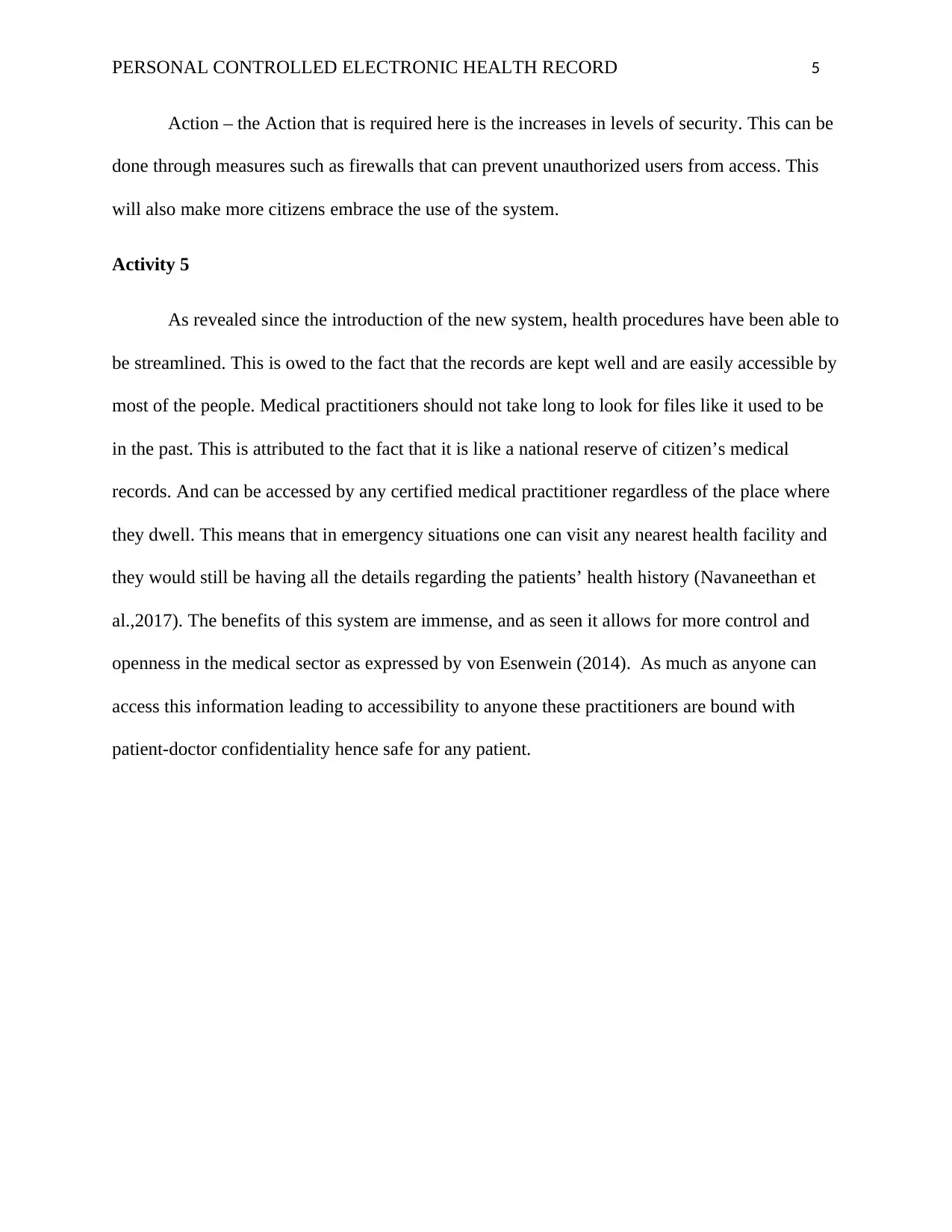
PERSONAL CONTROLLED ELECTRONIC HEALTH RECORD 5
Action – the Action that is required here is the increases in levels of security. This can be
done through measures such as firewalls that can prevent unauthorized users from access. This
will also make more citizens embrace the use of the system.
Activity 5
As revealed since the introduction of the new system, health procedures have been able to
be streamlined. This is owed to the fact that the records are kept well and are easily accessible by
most of the people. Medical practitioners should not take long to look for files like it used to be
in the past. This is attributed to the fact that it is like a national reserve of citizen’s medical
records. And can be accessed by any certified medical practitioner regardless of the place where
they dwell. This means that in emergency situations one can visit any nearest health facility and
they would still be having all the details regarding the patients’ health history (Navaneethan et
al.,2017). The benefits of this system are immense, and as seen it allows for more control and
openness in the medical sector as expressed by von Esenwein (2014). As much as anyone can
access this information leading to accessibility to anyone these practitioners are bound with
patient-doctor confidentiality hence safe for any patient.
Action – the Action that is required here is the increases in levels of security. This can be
done through measures such as firewalls that can prevent unauthorized users from access. This
will also make more citizens embrace the use of the system.
Activity 5
As revealed since the introduction of the new system, health procedures have been able to
be streamlined. This is owed to the fact that the records are kept well and are easily accessible by
most of the people. Medical practitioners should not take long to look for files like it used to be
in the past. This is attributed to the fact that it is like a national reserve of citizen’s medical
records. And can be accessed by any certified medical practitioner regardless of the place where
they dwell. This means that in emergency situations one can visit any nearest health facility and
they would still be having all the details regarding the patients’ health history (Navaneethan et
al.,2017). The benefits of this system are immense, and as seen it allows for more control and
openness in the medical sector as expressed by von Esenwein (2014). As much as anyone can
access this information leading to accessibility to anyone these practitioners are bound with
patient-doctor confidentiality hence safe for any patient.
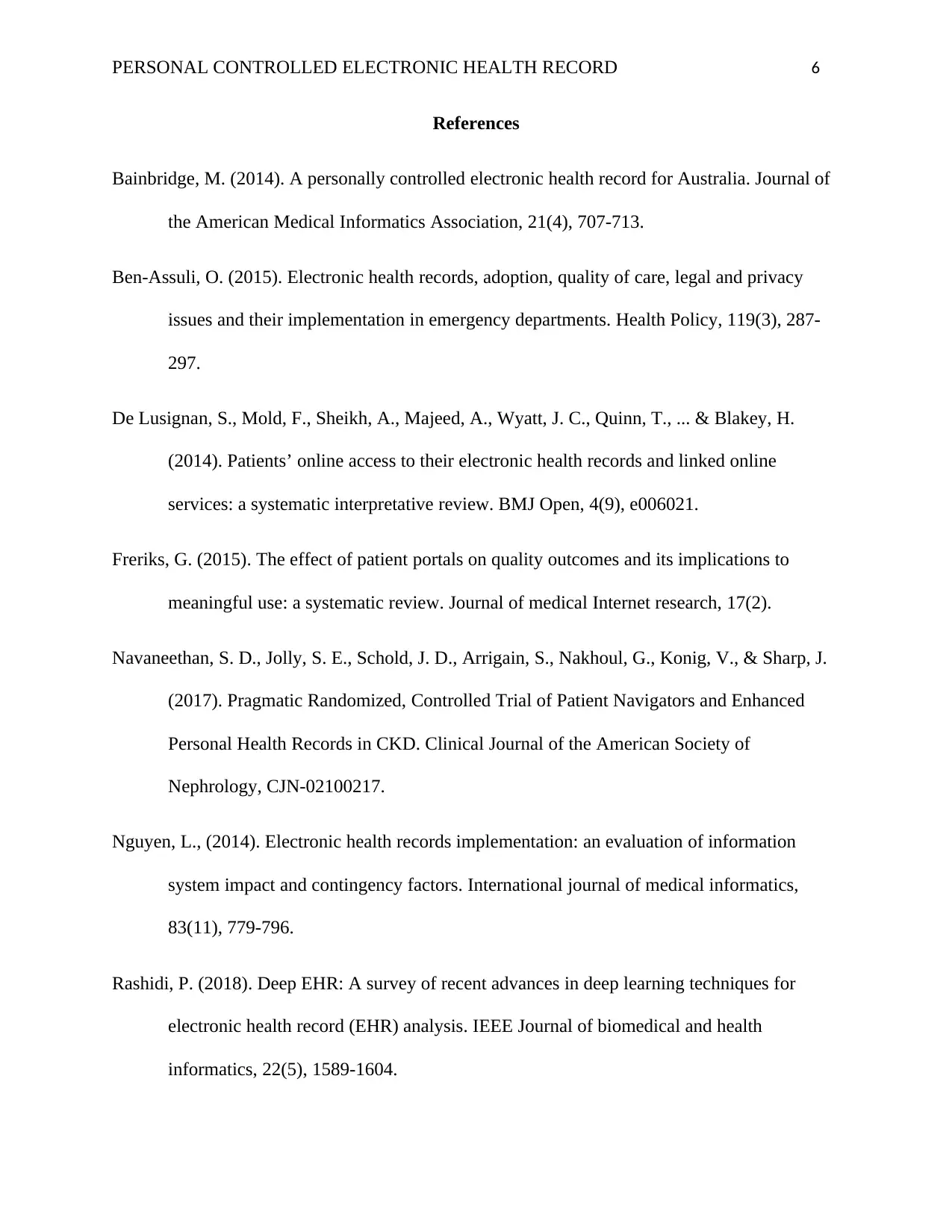
PERSONAL CONTROLLED ELECTRONIC HEALTH RECORD 6
References
Bainbridge, M. (2014). A personally controlled electronic health record for Australia. Journal of
the American Medical Informatics Association, 21(4), 707-713.
Ben-Assuli, O. (2015). Electronic health records, adoption, quality of care, legal and privacy
issues and their implementation in emergency departments. Health Policy, 119(3), 287-
297.
De Lusignan, S., Mold, F., Sheikh, A., Majeed, A., Wyatt, J. C., Quinn, T., ... & Blakey, H.
(2014). Patients’ online access to their electronic health records and linked online
services: a systematic interpretative review. BMJ Open, 4(9), e006021.
Freriks, G. (2015). The effect of patient portals on quality outcomes and its implications to
meaningful use: a systematic review. Journal of medical Internet research, 17(2).
Navaneethan, S. D., Jolly, S. E., Schold, J. D., Arrigain, S., Nakhoul, G., Konig, V., & Sharp, J.
(2017). Pragmatic Randomized, Controlled Trial of Patient Navigators and Enhanced
Personal Health Records in CKD. Clinical Journal of the American Society of
Nephrology, CJN-02100217.
Nguyen, L., (2014). Electronic health records implementation: an evaluation of information
system impact and contingency factors. International journal of medical informatics,
83(11), 779-796.
Rashidi, P. (2018). Deep EHR: A survey of recent advances in deep learning techniques for
electronic health record (EHR) analysis. IEEE Journal of biomedical and health
informatics, 22(5), 1589-1604.
References
Bainbridge, M. (2014). A personally controlled electronic health record for Australia. Journal of
the American Medical Informatics Association, 21(4), 707-713.
Ben-Assuli, O. (2015). Electronic health records, adoption, quality of care, legal and privacy
issues and their implementation in emergency departments. Health Policy, 119(3), 287-
297.
De Lusignan, S., Mold, F., Sheikh, A., Majeed, A., Wyatt, J. C., Quinn, T., ... & Blakey, H.
(2014). Patients’ online access to their electronic health records and linked online
services: a systematic interpretative review. BMJ Open, 4(9), e006021.
Freriks, G. (2015). The effect of patient portals on quality outcomes and its implications to
meaningful use: a systematic review. Journal of medical Internet research, 17(2).
Navaneethan, S. D., Jolly, S. E., Schold, J. D., Arrigain, S., Nakhoul, G., Konig, V., & Sharp, J.
(2017). Pragmatic Randomized, Controlled Trial of Patient Navigators and Enhanced
Personal Health Records in CKD. Clinical Journal of the American Society of
Nephrology, CJN-02100217.
Nguyen, L., (2014). Electronic health records implementation: an evaluation of information
system impact and contingency factors. International journal of medical informatics,
83(11), 779-796.
Rashidi, P. (2018). Deep EHR: A survey of recent advances in deep learning techniques for
electronic health record (EHR) analysis. IEEE Journal of biomedical and health
informatics, 22(5), 1589-1604.
⊘ This is a preview!⊘
Do you want full access?
Subscribe today to unlock all pages.

Trusted by 1+ million students worldwide
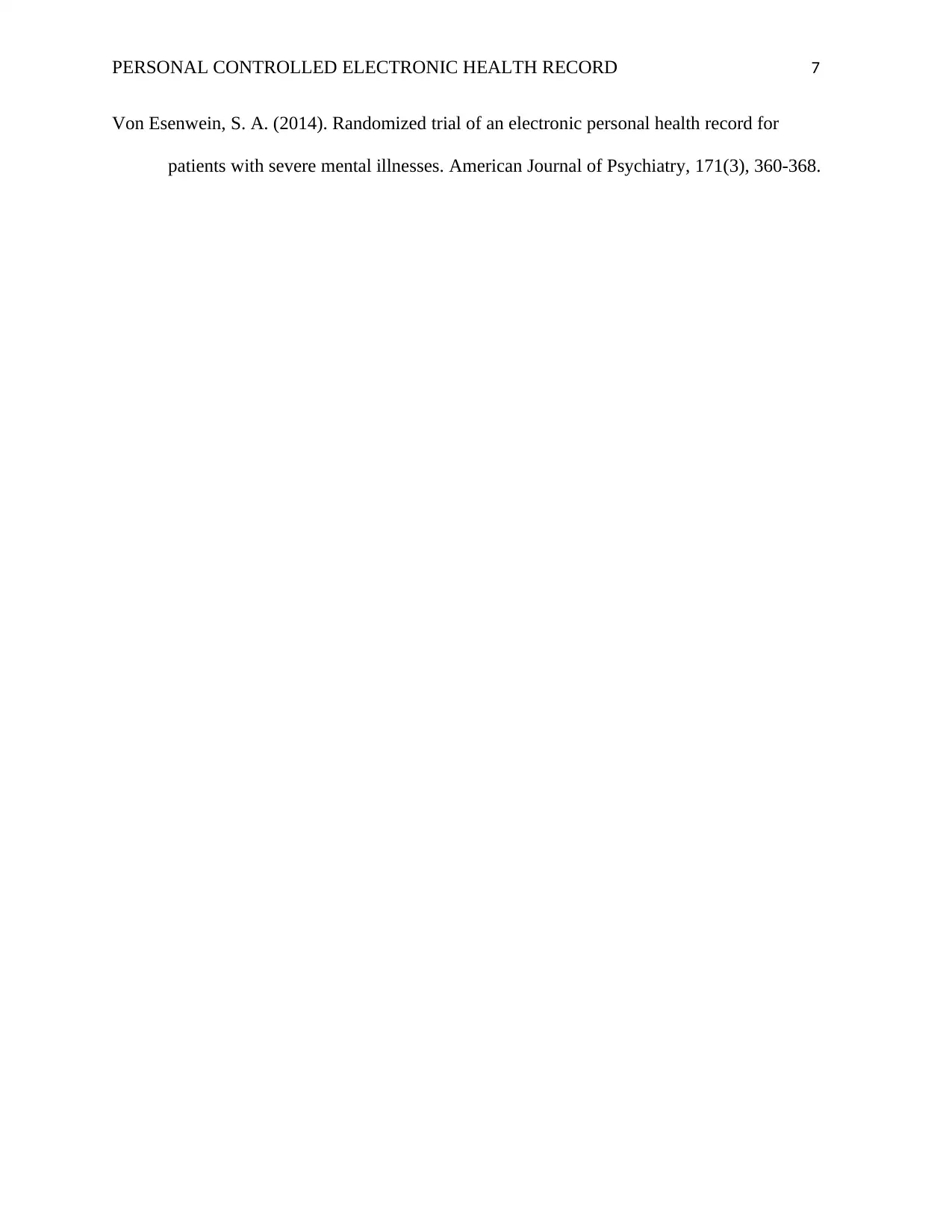
PERSONAL CONTROLLED ELECTRONIC HEALTH RECORD 7
Von Esenwein, S. A. (2014). Randomized trial of an electronic personal health record for
patients with severe mental illnesses. American Journal of Psychiatry, 171(3), 360-368.
Von Esenwein, S. A. (2014). Randomized trial of an electronic personal health record for
patients with severe mental illnesses. American Journal of Psychiatry, 171(3), 360-368.
1 out of 7
Related Documents
Your All-in-One AI-Powered Toolkit for Academic Success.
+13062052269
info@desklib.com
Available 24*7 on WhatsApp / Email
![[object Object]](/_next/static/media/star-bottom.7253800d.svg)
Unlock your academic potential
Copyright © 2020–2025 A2Z Services. All Rights Reserved. Developed and managed by ZUCOL.




